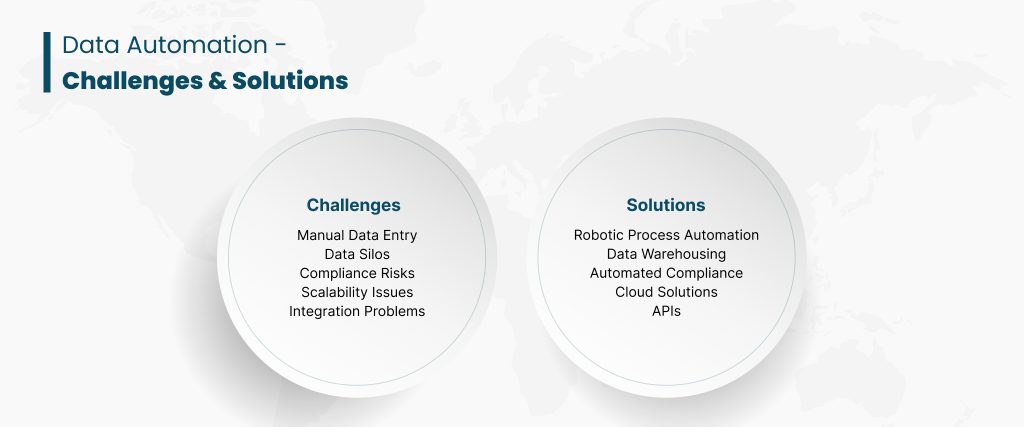While brokerage firms in the capital markets industry are increasingly aspiring to be data-driven, the ground reality often tells a different story. A 2022 survey by NewVantage Partners reports that only 19.3% have a strong data culture, and just 47.4% are investing in data analytics, revealing a significant gap between goals and reality.
Even more so, global regulatory changes like the SEC’s push for T+1 settlement and MiFID II’s stringent reporting requirements highlight the pressing need for real-time data analytics and advanced automation systems.
Why is Data Automation Essential?
To address the diversity and complexity of data management challenges in brokerage, strategic data automation is a great starting point. It involves using technology to manage, process, and analyze data without manual intervention. Given how manually-intensive several aspects of the trading workflow are, AI and NLP tools can help automate critical parts of the trade execution phase, mitigating risks, enhancing portfolio rebalancing, and reducing the margin for human error.
That said, it is often tempting to allocate a budget to “data,” “data analytics,” or “automation” and dive headlong into large-scale implementations with big-name solution providers. However, this rarely pans out as expected, leaving behind hefty bills and a host of integration issues. The best approach would be to start small and scale up gradually. By doing so, brokerages can steadily build a robust data infrastructure that evolves with their needs, avoiding the pitfalls of complex, expensive overhauls.

Leveraging Real-Time Data
A study by the International Swaps and Derivatives Association (ISDA) found that real-time monitoring can reduce operational risks by up to 30%.
Activities such as real-time data capture, automation of data collection, and report generation are crucial for brokers aiming to optimize their operations. Integrating data across the entire trading lifecycle—pre-trade, core-trade, and post-trade—not only ensures a seamless flow of information but also significantly reduces errors and enhances decision-making capabilities. The SEC benefits from automated data collection and integration through their MIDAS system, improving oversight capabilities. Real-time data allows the SEC to monitor trading activities more effectively, identifying suspicious transactions and potential market manipulations proactively.
In the pre-trade phase, before a trade is executed, brokers require comprehensive market data to inform their strategies. This includes historical data, real-time price feeds, and analytical insights. Automated tools that aggregate and analyze this data can provide brokers with a competitive edge. A report from Business Insider Intelligence highlighted that JPMorgan’s AI-based program, LOXM, outperformed human traders in terms of execution quality.
Implementing an execution report application during the trade execution phase can help brokers collect transaction data and generate detailed reports automatically.
Automating report generation in the post-trade phase can help brokers collect transaction data and generate detailed reports. These reports provide extensive analytics on every transaction, which is crucial for enhancing broker services and maintaining regulatory compliance. Charles Schwab, for example, uses automated report generation to streamline its post-trade operations, leading to a 30% reduction in processing time.
What are the SEC and FINRA Doing to Maintain Data Integrity?
The Consolidated Audit Trail (CAT) is a key initiative by the SEC that aims to create a comprehensive database to track all orders and trades in the U.S. equity and options markets. This initiative requires firms to capture and report detailed trading data. The CAT is expected to process over 58 billion records per day, highlighting the necessity of robust data automation systems to manage this volume effectively. Compliance with CAT ensures transparency and enhances the SEC’s ability to monitor market activities and detect misconduct.
Another significant regulation is Regulation Systems Compliance and Integrity (Reg SCI), which mandates that key market participants, including exchanges and clearing agencies, implement robust technology to ensure the resilience, security, and integrity of their automated systems.
The Role of Custom Solutions for Data Automation
Starting with data automation can feel overwhelming, but partnering with a custom FinTech solutions provider who understands the intricacies of the trading world is a smart move. You may bank on a Silicon Valley giant to excel in cutting-edge technology, but they often lack a nuanced understanding of trading ecosystems. Instead, you require a partner with profound knowledge of both the trading domain and technology who works alongside you to align your business objectives with tech.
At Ionixx, we leverage our industry-specific expertise to integrate seamlessly with your existing tech infrastructure. We believe in an incremental approach, where each automation step adds real value and helps you maintain your daily operations. Talk to us now. You can start small with a pilot automation project at a low investment with little risk. If successful, we’ll roll it out more widely, ensuring a seamless and effective transition.


